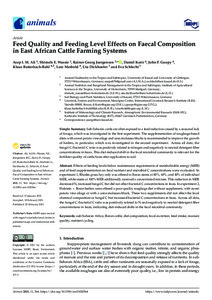| dc.date.accessioned | 2021-04-19T09:58:23Z | |
| dc.date.available | 2021-04-19T09:58:23Z | |
| dc.date.issued | 2021-02-22 | |
| dc.identifier | doi:10.17170/kobra-202104163697 | |
| dc.identifier.uri | http://hdl.handle.net/123456789/12723 | |
| dc.description.sponsorship | Gefördert durch den Publikationsfonds der Universität Kassel | ger |
| dc.language.iso | eng | eng |
| dc.rights | Namensnennung 4.0 International | * |
| dc.rights.uri | http://creativecommons.org/licenses/by/4.0/ | * |
| dc.subject | sub-Sahara Africa | eng |
| dc.subject | Boran cattle | eng |
| dc.subject | diet composition | eng |
| dc.subject | fecal excretion | eng |
| dc.subject | feed intake | eng |
| dc.subject | manure quality | eng |
| dc.subject | nutrient cycling | eng |
| dc.subject.ddc | 590 | |
| dc.subject.ddc | 630 | |
| dc.title | Feed Quality and Feeding Level Effects on Faecal Composition in East African Cattle Farming Systems | eng |
| dc.type | Aufsatz | |
| dcterms.abstract | Simple Summary
Sub-Saharan cattle are often exposed to a feed reduction caused by a seasonal lack of forage, which was investigated in the first experiment. The supplementation of roughage-based diets with sweet potato vine silage and urea molasses blocks is recommended to improve the growth of heifers, in particular, which was investigated in the second experiment. Across all data, the fungal C/bacterial C ratio was positively related to nitrogen and negatively to neutral detergent fiber concentrations in feces. This diet-induced shift in the fecal microbial community is relevant for the fertilizer quality of cattle faces after application to soil.
Abstract
Effects of feeding levels below maintenance requirements of metabolizable energy (MER) and of feed supplementation on fecal nutrient and microbial C concentrations were evaluated. In experiment 1, Rhodes grass hay only was offered to Boran steers at 80%, 60%, and 40% of individual MER, while steers at 100% MER additionally received a concentrated mixture. This reduction in MER decreased N, increased fungal C but did not affect bacterial C concentrations in feces. In experiment 2, Holstein × Boran heifers were offered a poor-quality roughage diet without supplement, with sweet potato vine silage or with a urea-molasses block. These two supplements did not affect the fecal chemical composition or fungal C but increased bacterial C concentrations in feces. Across all data, the fungal C/bacterial C ratio was positively related to N and negatively to neutral detergent fiber concentrations in feces, indicating diet-induced shifts in the fecal microbial community. | eng |
| dcterms.accessRights | open access | |
| dcterms.creator | Ali, Asep Indra Munawar | |
| dcterms.creator | Wassie, Shimels Eshete | |
| dcterms.creator | Jörgensen, Rainer Georg | |
| dcterms.creator | Korir, Daniel | |
| dcterms.creator | Goopy, John Patrick | |
| dcterms.creator | Butterbach-Bahl, Klaus | |
| dcterms.creator | Merbold, Lutz | |
| dcterms.creator | Dickhöfer, Uta | |
| dcterms.creator | Schlecht, Eva | |
| dc.relation.doi | doi:10.3390/ani11020564 | |
| dc.subject.swd | Subsaharisches Afrika | ger |
| dc.subject.swd | Boran <Rind> | ger |
| dc.subject.swd | Futtermittel | ger |
| dc.subject.swd | Zusammensetzung | ger |
| dc.subject.swd | Exkretion | ger |
| dc.subject.swd | Futteraufnahme | ger |
| dc.subject.swd | Gülle | ger |
| dc.subject.swd | Nährstoffkreislauf | ger |
| dc.type.version | publishedVersion | |
| dcterms.source.identifier | EISSN 2076-2615 | |
| dcterms.source.issue | Issue 2 | |
| dcterms.source.journal | Animals | eng |
| dcterms.source.volume | Volume 11 | |
| kup.iskup | false | |
| dcterms.source.articlenumber | 564 | |


